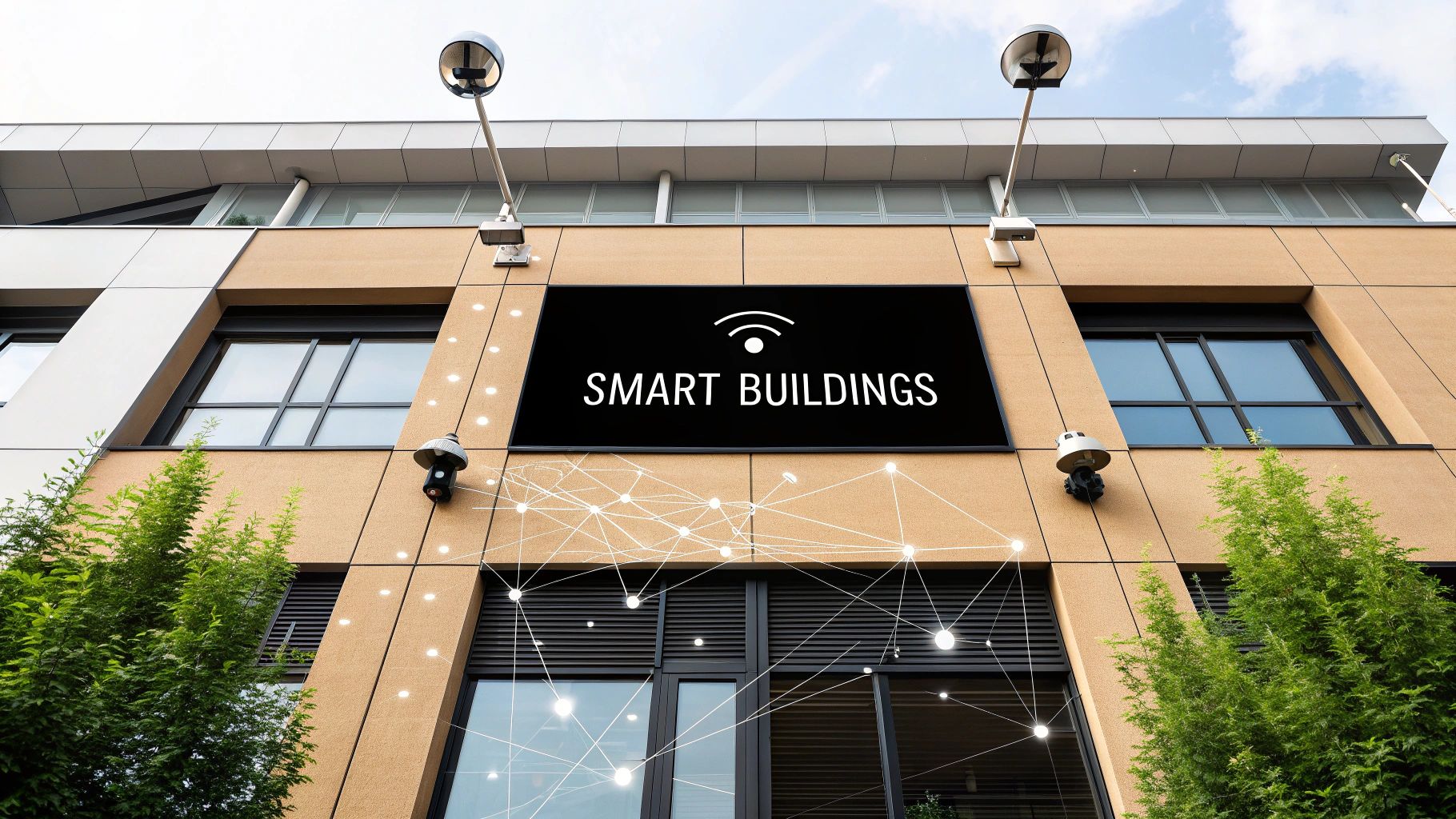Think of a building's systems—heating, lighting, security—as a collection of talented musicians. In a traditional building, they’re all playing their own tune, completely unaware of each other. The result? A lot of noise and wasted effort.
Now, what if you gave them a conductor? That’s exactly what the Internet of Things (IoT) does for a building. It acts as the conductor, orchestrating all the separate systems so they work together in perfect harmony.
What Is the Internet of Things in Buildings?
At its core, IoT gives a building a central nervous system. It's a network of interconnected devices, sensors, and equipment that constantly talk to each other and a central hub. Instead of being a static structure of concrete and steel, the building becomes a living, breathing ecosystem that can sense, think, and act on its own.
This network is made up of countless small, smart devices embedded throughout the property. These can be anything from temperature sensors in an office and occupancy monitors in a conference room to smart lightbulbs and even sensors on an HVAC unit. They all gather real-time data about what’s happening in and around the building.
From Data to Action
This constant stream of data is where the real value comes in. A central platform collects all this information, analyzes it, and uses the insights to make intelligent, automated decisions. It’s a simple but powerful feedback loop.
Here’s what that looks like in the real world:
- Occupancy sensors notice a meeting room has been empty for 15 minutes, so they tell the system to dim the lights and turn down the AC.
- Sensors on the windows detect the intense afternoon sun and signal the smart blinds to close, reducing solar heat gain and easing the burden on the cooling system.
- A vibration sensor on an air handler detects an unusual pattern, predicting a potential failure and automatically scheduling a maintenance ticket before the unit breaks down.
This move from reactive, manual adjustments to proactive, data-driven automation is a massive shift for property management. And the market is taking notice. The global smart building sector was valued at $126.58 billion in 2024 and is expected to explode to $571.28 billion by 2030, a surge largely fueled by the push for greater energy efficiency. You can dig into the numbers yourself in this Grand View Research market analysis.
In essence, IoT transforms a building from a passive container into an active participant in its own management. It stops being a collection of isolated systems and becomes a single, cohesive, and intelligent entity.
Ultimately, bringing the Internet of Things into buildings is about creating spaces that are smarter, safer, more comfortable, and far more efficient. It gives facility managers and property owners the visibility and control they need to slash operating costs while dramatically improving the experience for everyone inside.
How Smart Building Architecture Actually Works
To really get what makes a smart building tick, it helps to peek under the hood. While the tech can seem intimidating, the architecture behind it is surprisingly logical. The best way to think about it is as a four-layer system, working together almost like a human body, to turn raw information from the physical world into smart, automated actions.
It all starts with the building’s “senses” and “muscles.”
Layer 1: The Device Layer
This is the ground floor of any smart building system. The device layer is a massive network of sensors that gather data and actuators that get things done. These are literally the "things" in the Internet of Things.
Sensors are the building's eyes, ears, and nerve endings, collecting a constant stream of information about the surrounding environment. Actuators, on the other hand, are the muscles. They take orders from the system and make a physical change.
A few common examples include:
- Sensors: Occupancy sensors that know when someone enters a room, temperature and humidity sensors for climate control, light sensors that measure how bright it is, and even vibration sensors on machinery to predict when maintenance is needed.
- Actuators: Smart thermostats that adjust the AC, automated window blinds, smart locks that grant access, and dimmable LED lights.
Once a sensor gathers a piece of data—say, a room's temperature hits 74°F—that information has to go somewhere. That's where the next layer comes into play.
This infographic gives you a simple visual of how data flows from sensors to an automated action.
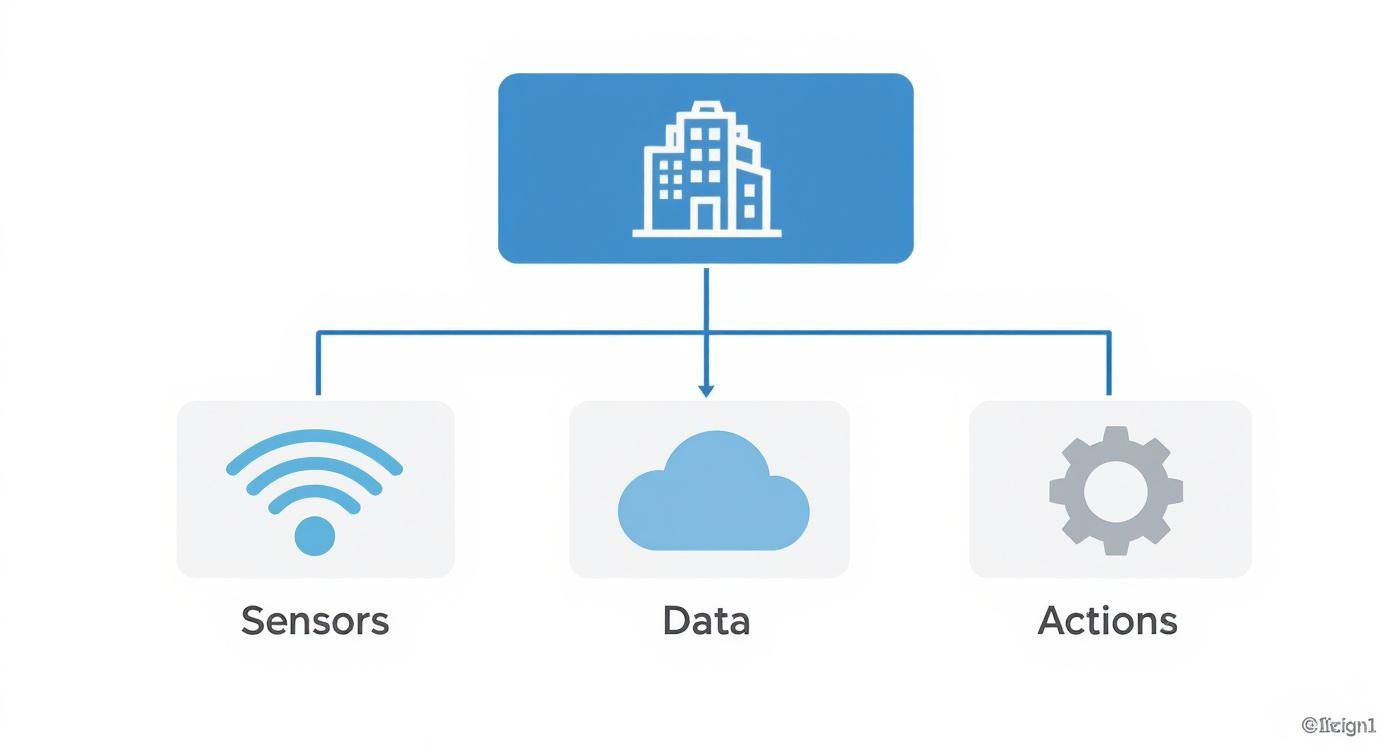
It shows how all these connected devices create a loop of information that lets the building respond intelligently.
Layer 2: The Connectivity Layer
If the devices are the senses, then the connectivity layer is the building's central nervous system. Its sole job is to shuttle all that data from the sensors to a central hub for processing. This layer is all about the network infrastructure and communication protocols that let devices talk to each other and to the cloud.
Most buildings use a mix of wireless and wired tech, picking the right tool for the job.
- Wi-Fi: A go-to for high-bandwidth devices like security cameras that need to send a lot of data.
- Bluetooth Low Energy (BLE): Perfect for short-range tasks, like using your phone as a key for a smart lock.
- Zigbee and Z-Wave: These are low-power mesh networks, ideal for connecting huge numbers of simple devices like lightbulbs and sensors without draining their batteries.
- LoRaWAN: A long-range, low-power option that’s fantastic for covering big properties or connecting devices in tough-to-reach spots.
This data pipeline is the crucial link that gets raw information from the edge to the brain of the operation.
A smart building is only as good as its network. The connectivity layer has to be strong enough to handle thousands of data streams at once without a hiccup, making sure information flows smoothly from sensor to decision.
Layer 3: The Platform Layer
Now we've arrived at the brain of the smart building. The platform layer, which is usually based in the cloud, is where all the raw data gets collected, stored, and analyzed. This is the spot where a simple data point like "74°F" is turned into a useful insight, like, "The conference room on the third floor is too warm."
This layer runs powerful software to spot patterns, trigger alerts, and make decisions based on rules you've set. For facility managers, this is where the magic of what is building automation system truly happens, allowing complex operations to run on autopilot. The platform might pull in data from the HVAC, lighting, and room booking systems to create one unified picture of what’s going on.
Layer 4: The Application Layer
Finally, we have the application layer. This is the user-facing part of the whole system—the "face" of the smart building. It takes all that processed data and presents it in a way that people can actually use, whether through a dashboard, a mobile app, or a control panel.
This is how people interact with the building’s intelligence. A facility manager might use a dashboard to track energy use across their entire portfolio. An employee might use a mobile app to book a meeting room and set the temperature before they even walk in. This final layer is what makes a building's smarts accessible, manageable, and genuinely helpful.
Putting IoT to Work in Your Building
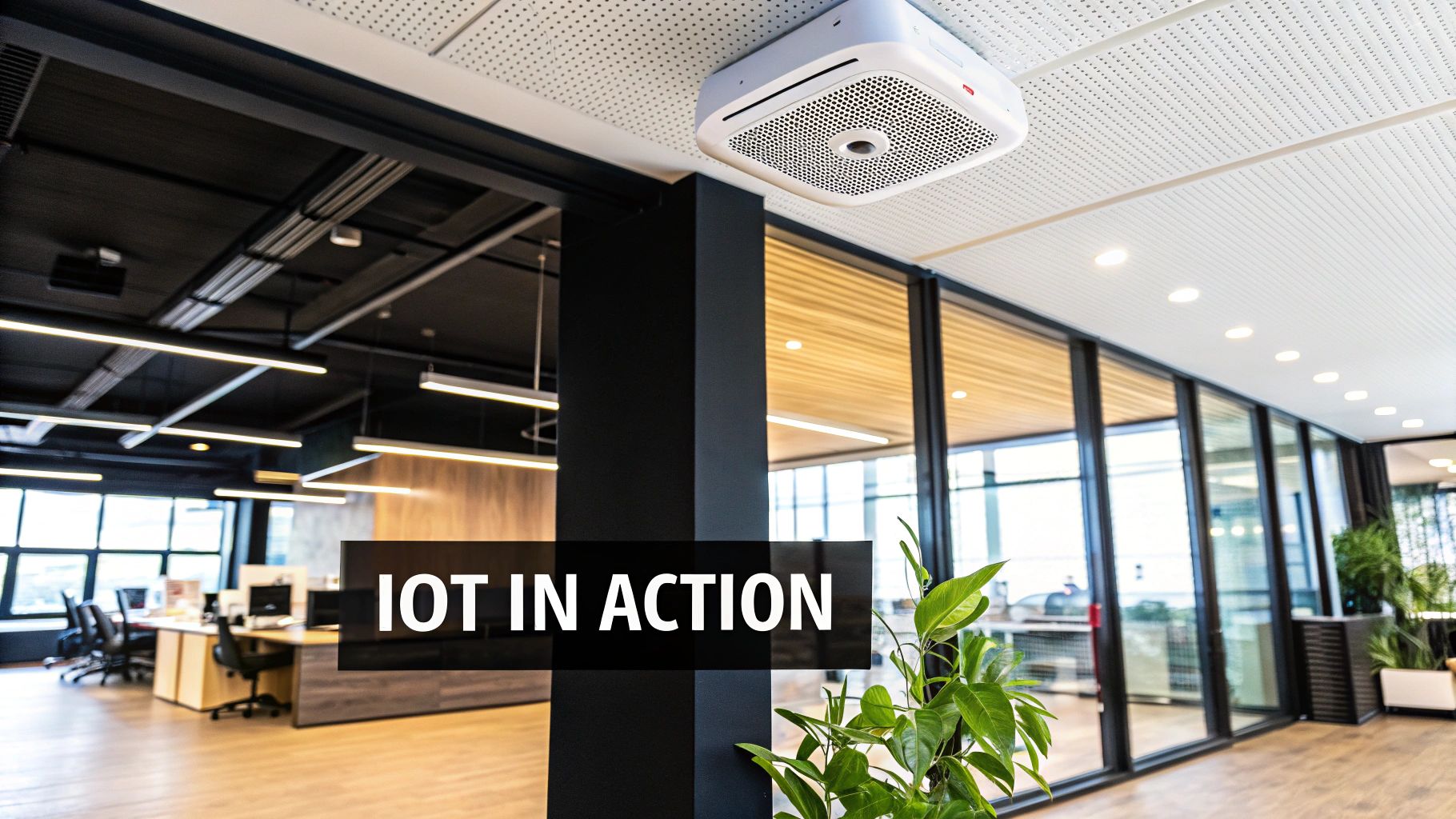
It's one thing to understand the architecture, but seeing the internet of things in buildings in action is where the real value clicks. We’re moving beyond abstract data points to real-world results that save money, boost safety, and just make buildings better places to be. These aren't far-off ideas; they're practical tools solving everyday headaches for facility managers right now.
Think about an HVAC unit on a commercial rooftop in the middle of a brutal summer. A small, inexpensive IoT sensor picks up a faint, abnormal vibration—a sound no human would ever notice. Instead of waiting for a catastrophic failure during a heatwave, the system flags the unit, generates a maintenance ticket, and pings the facilities team with specific diagnostic info. That’s predictive maintenance in a nutshell, and it’s a game-changer for preventing costly emergency repairs and getting more life out of your equipment.
Enhancing Energy Efficiency and Sustainability
One of the quickest wins with IoT is tackling energy consumption. Buildings are notoriously wasteful, but connected systems bring a whole new level of intelligence to how we use resources.
- Smart Lighting: Occupancy sensors make sure lights are on only when someone's in the room, automatically dimming or shutting off when it's empty. Light sensors can also adjust indoor brightness based on how much natural daylight is coming in, keeping things perfectly lit while slashing electricity bills.
- HVAC Optimization: This is a big one. IoT systems look at data from temperature sensors, occupancy patterns, and even local weather forecasts to heat and cool spaces more efficiently. No more blasting the AC to 68°F on an empty office floor over the weekend—a huge source of waste.
These smart adjustments aren't just fancy timers. They create a living, breathing energy profile for the building that responds to what's actually happening, leading to serious savings and a much smaller carbon footprint.
Improving Building Operations and Occupant Experience
Beyond the utility bills, IoT makes the day-to-day management of a property smoother and improves the experience for everyone inside. The market is exploding for a reason; what was a $25 billion industry for IoT in smart buildings in 2025 is on track to hit nearly $80 billion by 2033.
This growth is all about practical applications. For instance, sensors can tell you exactly how different parts of an office are being used. This space utilization data helps companies make smarter decisions about layouts, spot underused meeting rooms, and get the most out of their real estate. For anyone in property management, these insights are gold. To learn more, check out our guide on how IoT in property management is transforming the field.
IoT gives you the data-driven visibility to manage a building based on reality, not on guesswork. It finally answers questions like, "Which spaces are most valuable?" and "Where are my operational bottlenecks?"
Strengthening Security and Access Control
Connected systems also add some serious muscle to your security. Old-school keys and keycards are giving way to smart access control that uses phones or biometrics. This approach has some major advantages:
- Granular Control: You can grant access to specific areas for specific times and instantly revoke permissions from your desk when an employee leaves.
- Detailed Audit Trails: The system logs every entry and exit attempt, giving you a crystal-clear record of who was where and when.
- Integrated Safety: Link access control with security cameras and alarms. If a door is forced open, the system can automatically lock down other zones, tell cameras to start recording, and send an instant alert to security.
To get the most out of these tools, it's important to align them with broader facility management best practices. When you do, you’ll see that the internet of things in buildings is the key to turning a static property into a highly efficient, secure, and responsive asset.
The Real-World Benefits of an IoT System
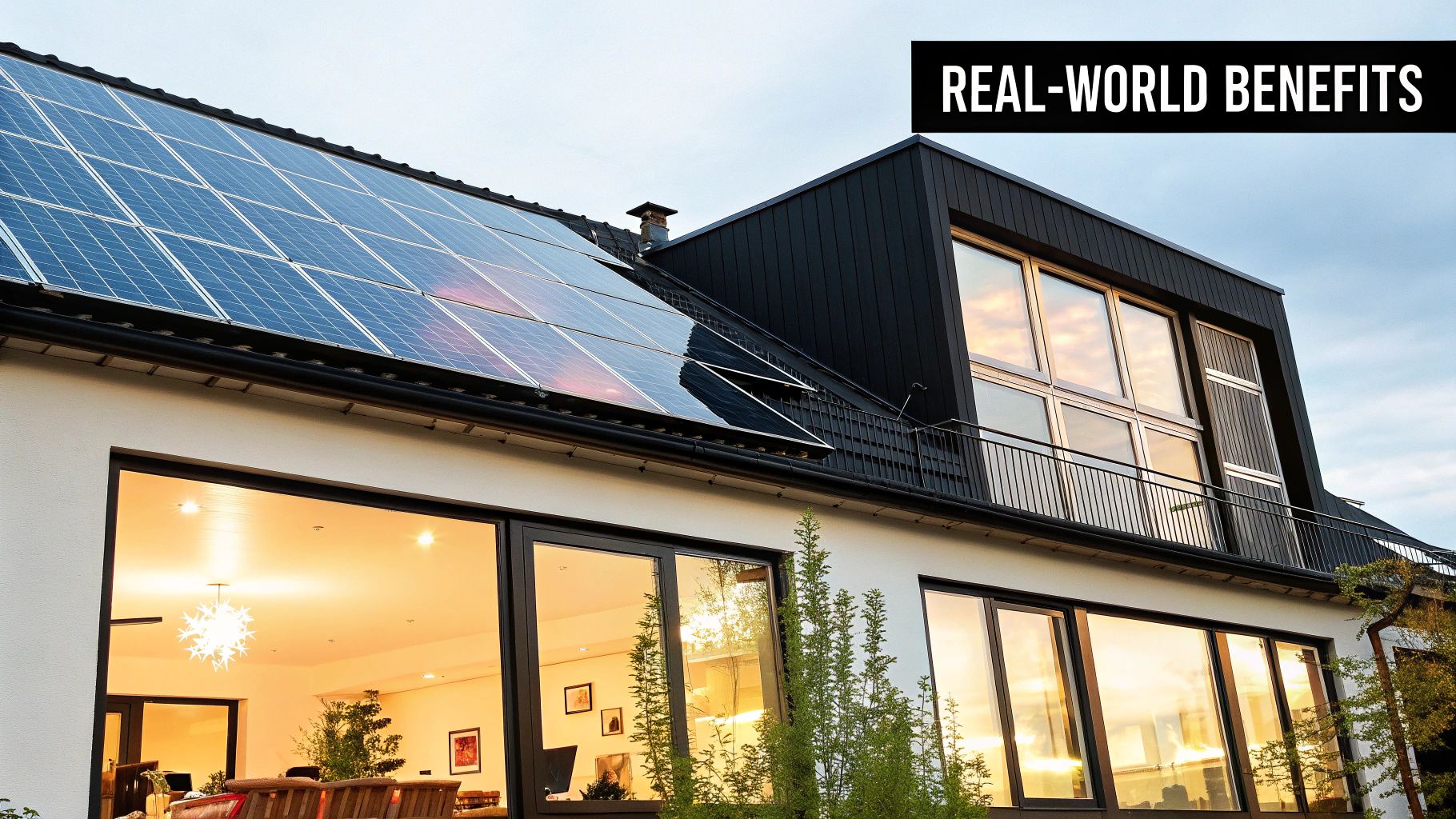
Putting an IoT system into your building isn't just a tech upgrade; it's a fundamental business decision that pays you back in very real ways. The value of the internet of things in buildings really boils down to three key wins: smarter savings, happier people, and a healthier planet.
When you look at it this way, IoT stops being a "nice-to-have" and becomes a core asset for any modern property owner or facility manager.
The most obvious and immediate payoff hits your bottom line. Smart buildings are simply more efficient, and that efficiency translates directly into lower operating costs. By giving you a constant stream of real-time data, an IoT system uncovers waste you never even knew was there.
Drive Smarter Savings
The two biggest money-savers are predictive maintenance and fine-tuned energy use. Instead of waiting for a critical piece of equipment to break down, IoT sensors can spot the warning signs early. This lets you schedule repairs before something catastrophic happens. Taking this proactive approach can cut operational costs by as much as 30% while extending the life of your expensive HVAC systems.
But where you'll really see the savings pile up is in energy optimization.
- Intelligent Climate Control: The system figures out when and where people are, so it’s not wasting money heating or cooling empty rooms.
- Responsive Lighting: Sensors dim or turn off lights based on who’s in the room and how much natural sunlight is available.
- Peak Demand Management: The system is smart enough to dial back non-essential power use during the most expensive times of the day, helping you avoid those painful utility surcharges.
It's this kind of detailed control that makes sure every utility dollar is working as hard as it possibly can.
Create Happier People
Beyond the spreadsheets and utility bills, a smart building just feels better to be in. We all know that comfort and productivity are tied to our environment, and an IoT system offers a personalized experience that a traditional building can't touch.
Imagine tenants using a simple app on their phones to tweak the temperature and lighting in their own office space. The system can also keep an eye on air quality, monitoring things like CO2 levels and automatically kicking up the ventilation when the air gets stale. When you focus on people's well-being, you get higher satisfaction, fewer complaints, and a workforce that can actually focus on their jobs.
A smart building actively works to create an optimal human experience. It anticipates needs and fine-tunes the environment, turning a static space into a partner in comfort and productivity.
In today's competitive real estate market, creating this kind of people-first environment is what attracts and keeps the best tenants.
Build a Healthier Planet
Finally, bringing IoT into your building is a significant step toward genuine sustainability. By slashing energy waste, smart buildings shrink their carbon footprint. This helps property owners meet tough environmental regulations and hit their own corporate sustainability targets.
The data you get also gives you clear, provable reports on energy, water, and waste, so you can back up your commitment to running a green operation. This isn't just a trend; it's a major shift in how we build. The U.S. market for IoT in construction hit $5.62 billion in 2025 and is only getting bigger, pushed by the demand for smarter, more sustainable buildings. You can dig into the numbers in the latest IoT in Construction report.
At the end of the day, an IoT system shows that what's good for the planet can also be very, very good for business.
Navigating Your First IoT Deployment
Taking the first step into an internet of things in buildings project can feel like a monumental task, but it doesn't have to be. The secret is to break the process down into manageable pieces and tackle the most common hurdles right from the start.
By truly understanding the big three—cost, security, and complexity—you can build a clear roadmap for a successful rollout. This isn't about flipping a switch and making your entire building smart overnight. It's a strategic, step-by-step process designed to deliver real value from day one.
Addressing the Initial Investment
Let's be honest, the first question is always about the price tag. While an IoT deployment is a significant investment, thinking of it as one massive, all-or-nothing expense is a classic mistake. The best approach is a phased rollout, which lets you prove the return on investment (ROI) quickly and build momentum.
Start small by focusing on a single, high-impact problem. Is energy consumption your biggest operational headache? Then begin with smart lighting or HVAC sensors in one specific area of your building. By targeting a known pain point, you can generate clear, measurable savings that make a powerful case for the next phase.
Think of your first IoT project as a pilot program. The goal is to demonstrate value quickly, get stakeholders on board, and learn crucial lessons before you scale up across the rest of the property.
This strategy turns a daunting capital expenditure into a series of smaller, justifiable projects. Each successful phase helps fund the next, creating a self-sustaining cycle of improvement that fits neatly into your operational budget.
As this diagram of a building automation system shows, you don't have to connect everything at once. You can start with one system, like energy management, and gradually integrate others like lighting and security over time.
Fortifying Your Building's Digital Security
The moment you connect building systems to the internet, cybersecurity has to be at the top of your list. A security breach could do more than just disrupt operations—it could compromise sensitive tenant or corporate data. Fortunately, these risks are completely manageable with the right strategy.
One of the most effective security measures is network segmentation. Think of your building’s network like a ship with multiple watertight compartments. Segmentation creates digital barriers that separate your IoT devices from your core corporate network. This way, if one sensor were somehow compromised, the threat would be contained and couldn't spread to critical business systems like finance or HR.
Here are a few essential security practices to bake in from the beginning:
- Use Strong Encryption: All data moving between your devices, gateways, and the cloud should be encrypted. It's the digital equivalent of sending information in a locked safe.
- Enforce Strict Access Controls: Not everyone needs the keys to the entire building. Implement role-based permissions to ensure people can only see and control what's necessary for their job.
- Keep Firmware Updated: Work with vendors who are serious about security. They should provide regular patches and have a clear process for keeping all your device firmware up to date.
Security isn't something you bolt on at the end; it must be designed into your internet of things in buildings strategy from day one.
Taming System Complexity
The final hurdle is complexity. With so many vendors, devices, and platforms on the market, it's easy to get locked into a proprietary system that doesn’t play well with others. This "vendor lock-in" can kill innovation and lead you down an expensive dead end.
The solution? Prioritize systems built on open protocols and APIs. Open protocols act like a universal translator, allowing devices from different manufacturers to communicate with each other. This gives you the freedom to choose the best-in-class device for each specific job, rather than being stuck with one company's entire lineup.
When you’re evaluating potential partners like Clouddle Inc, always ask about their approach to integration. A good partner will help you build a flexible, future-proof system that can adapt as new technologies appear. This focus on interoperability is what turns a collection of gadgets into a cohesive, intelligent building that actually works for you.
The Future of IoT and Intelligent Buildings
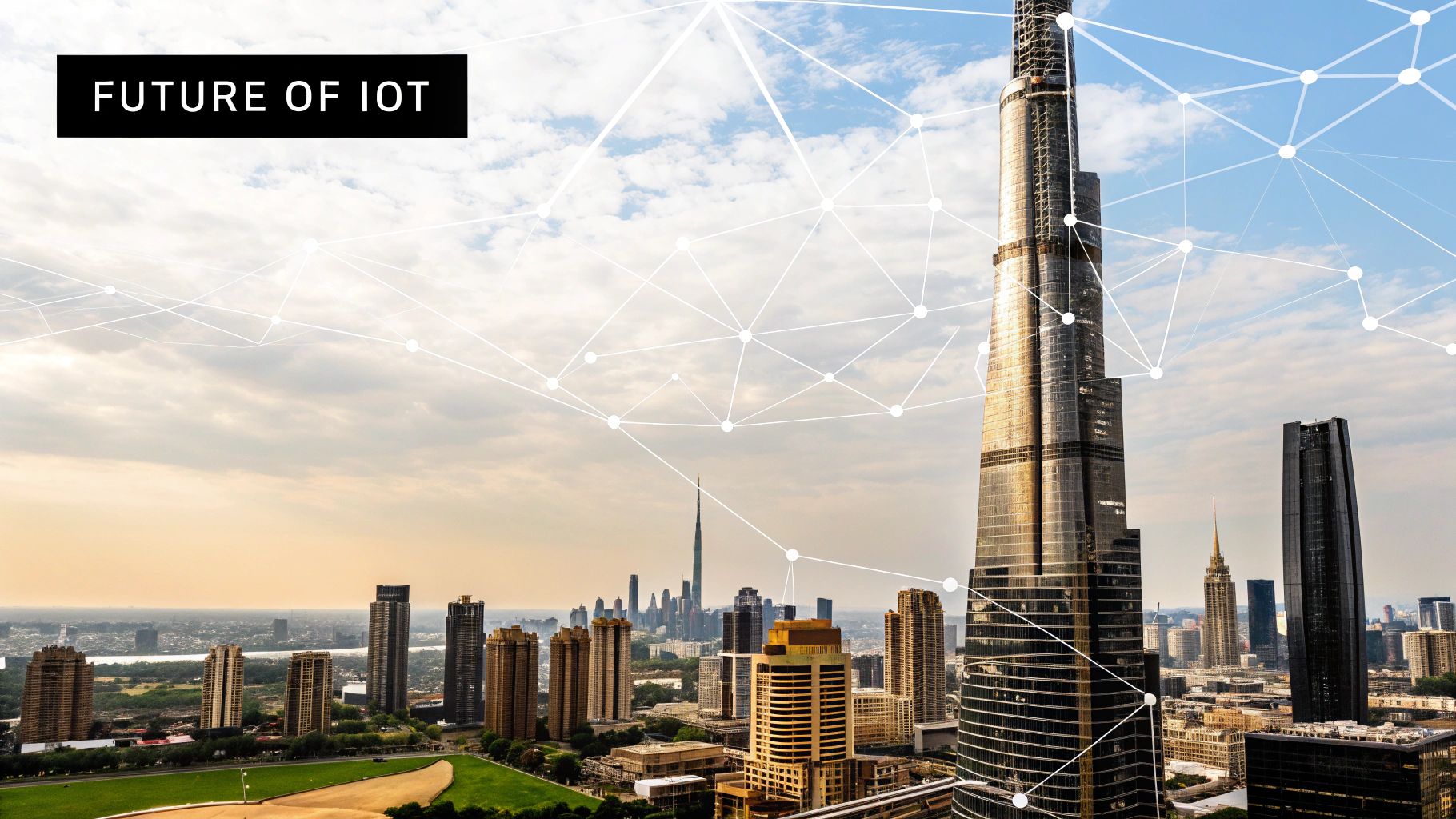
We've only scratched the surface of what the internet of things in buildings can do. We're moving past simple, pre-programmed automation and into an era where buildings become genuinely intelligent partners in managing a property. The future isn’t just about adding more sensors; it’s about what we can achieve with the information they gather.
This next wave is being driven by artificial intelligence (AI) and machine learning. Soon, our buildings will learn from occupant behavior. They'll spot patterns in how spaces are used, anticipate energy needs, and understand daily routines to make decisions on their own. Picture an office that automatically reconfigures its HVAC and lighting based on which teams are working together, all without a single person touching a control panel.
Digital Twins and Healthy Buildings
One of the most exciting concepts on the horizon is the digital twin. The best way to think of it is as a perfect virtual replica of your physical building, constantly updated in real-time with data streaming in from every IoT device.
A digital twin gives facility managers a sandbox to run simulations and test changes without any real-world risk. Before you spend a dime on an actual renovation or system upgrade, you can see exactly how it will affect energy bills, foot traffic, and tenant comfort.
This technology completely closes the gap between the physical and digital worlds, offering a crystal ball into your building's operations. At the same time, we're seeing a huge push toward creating "healthy buildings." This movement uses IoT to continuously watch over and improve the indoor environment for the people inside.
The main areas of focus are:
- Air Quality: Sensors constantly track things like CO2, volatile organic compounds (VOCs), and tiny airborne particles, triggering ventilation systems to keep the air fresh and clean.
- Lighting: Smart lighting can change its color temperature and brightness throughout the day to match our natural circadian rhythms, boosting alertness and overall well-being.
- Acoustics: Sound sensors can pinpoint noise pollution hotspots, helping managers create calmer, more focused, and less stressful spaces.
These developments are turning buildings from static concrete-and-steel structures into living, breathing ecosystems. They are becoming active players in driving efficiency, sustainability, and human health. As these systems connect and learn from one another, they set the stage for even more advanced smart living technologies that will fundamentally change how we interact with the places we live and work.
Got Questions? We've Got Answers
Jumping into the world of smart buildings can feel a little daunting, even when you know the benefits. It's only natural for property owners and IT teams to have questions. Getting clear, straightforward answers is the best way to move forward with confidence and make sure your project is a home run.
Here are a few of the most common questions we hear—and the practical answers you need.
How Secure Is an IoT System in a Commercial Building?
This is often the first question people ask, and for good reason. Security isn't just a feature; it has to be baked into the very foundation of the system. A properly designed IoT deployment uses security in layers, starting right at the device level and extending all the way to the cloud.
Think of it like securing a physical building. You have locks on individual doors (device-level security), guards at the entrances (encrypted network communication), and a central security office monitoring everything (robust platform security with access controls).
One of the most important strategies is network segmentation. This simply means creating a separate, dedicated network for your IoT devices. It's like giving them their own private road so they can't interfere with your main corporate traffic. If a single device were ever compromised, the threat would be contained and couldn't spread to your core business systems.
A secure IoT deployment is a partnership. It relies on working with vendors who take security seriously and on your team staying on top of best practices, like keeping all software and firmware updated.
Can We Install This in an Older, Existing Building?
Absolutely. In fact, most IoT projects are retrofits. You don't need a brand-new building to get the benefits of smart technology. Many of the best solutions on the market today are designed specifically for older properties, minimizing disruption and avoiding the headache of pulling new wires through old walls.
Wireless sensors are a game-changer here. They use low-power technologies (like LoRaWAN or Zigbee) and can be placed just about anywhere. They then talk to your existing Building Management System (BMS) through a small gateway device, or they can operate as their own standalone system.
For older buildings, a phased approach works wonders. Start with the systems that will give you the biggest bang for your buck, like HVAC and lighting. Once you see the ROI from those upgrades, you can build momentum and expand from there.
What’s the Typical Return on Investment?
While every building is different, the financial upside of an IoT project is usually quite strong. The return comes from two main places: serious energy savings and a big drop in operational costs.
- Energy Savings: Just by optimizing your heating, cooling, and lighting, you can cut annual energy use by 15% to 30%.
- Operational Efficiency: Shifting from reactive repairs to predictive maintenance can slash your overall maintenance budget by 20% to 40%. You're fixing small issues before they become catastrophic failures.
But the numbers don't stop there. A smarter building is a more valuable asset and can command higher lease rates because it offers a better experience for tenants. Most projects pay for themselves in just two to five years, and the savings just keep rolling in after that. Investing in the internet of things in buildings isn't just a tech upgrade—it's a smart financial move.
Ready to transform your property into a smarter, more efficient, and secure asset? The experts at Clouddle Inc specialize in designing and deploying integrated technology solutions that deliver measurable results. Explore our managed IT and security services today to learn how we can help you unlock the full potential of your building.


